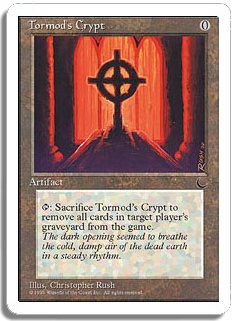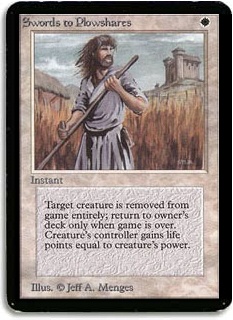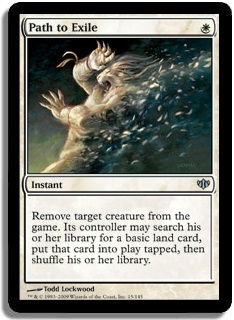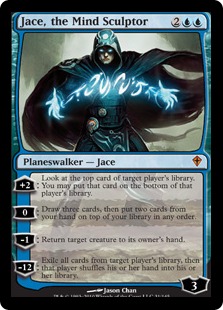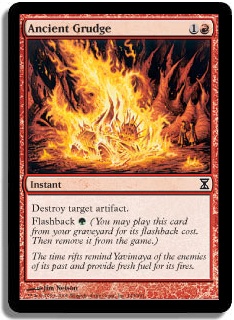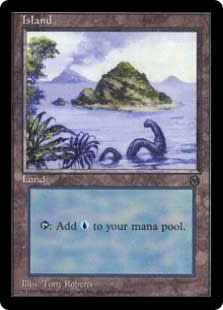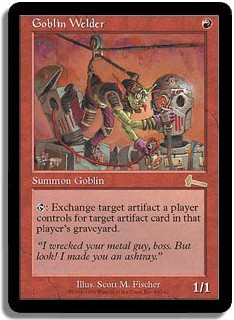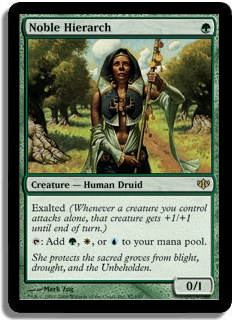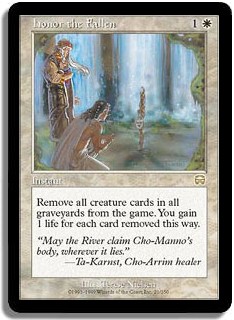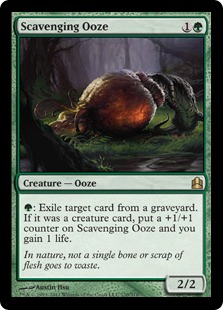Nostrademars Predicts…
When we last left off with "Mishra’s Workshop Strikes Back," I ended that article by saying:
"As for the continued evolution of Mishra’s Workshop, the first person to figure out how to play with Goblin Welder—and have it be actively great—probably gets to win a tournament."
Creatures (25)
- 3 Solemn Simulacrum
- 1 Karn, Silver Golem
- 2 Razormane Masticore
- 4 Goblin Welder
- 4 Magus of the Moon
- 4 Lodestone Golem
- 3 Phyrexian Revoker
- 4 Phyrexian Metamorph
Lands (17)
Spells (19)

Scott Hughes has moved away from the mana denial plan and back toward the soft lock/sphere disruption + attack with guys. However, what makes his deck unique is that he also has a lot of ways to create grindy card advantage, virtual card advantage, and board advantage.
In particular, the biggest innovation of this deck is that, like I suggested at the end of my last article, the first person to figure out how to build a good Goblin Welder deck won a tournament. Whereas the other Workshop decks are focused upon trying to Smokestack and play the mana denial game, which is very good in every non-Workshop Mirror matchup, Scott’s deck is equipped with 101 ways to beat up on Stax.
"Not all 4 drops are created equal in the Workshop mirror."
Casting a Solemn Simulacrum against a deck that’s trying to play Smokestack or simply dropping a Goblin Welder? There are few things better in the mirror match. He’s also got Magus of the Moon to blank Wastleland/Strip Mine + Crucible. Not to mention after sideboard, I’m pretty sure it doesn’t matter what Espresso Stax brings in because it can’t be better than Shattering Spree + Viashino Heretic.
So what makes Scott’s deck unique and well positioned? His deck is really, really good at answering permanents in a field where answering permanents is king.
For the record, with regard to Scott’s deck the one thing I specifically don’t like about it—but feel could be easily improved—is that I don’t think it’s built very well to beat Dredge. Now, it may be the case that he simply didn’t think that Dredge was going to be a big issue and tactically chose to ignore that matchup because he didn’t think he’d have to face it.
"Let’s keep things real here."
However, the fact that he plays four Goblin Welder seems like a really, really good reason to be playing Tormod’s Crypt out of the sideboard, especially over Relic of Progenitus—which I really don’t understand. He’s got four Grafdigger’s Cage, but I’d still like to see at least three Tormod’s Crypt out of the sideboard from a deck like this.
Mishra’s Workshop Continues to Thrive; Trygon Predator Tries to Reinvent Itself
Last weekend, between the Meandeck Open and the NEV III Vintage tournament, Mishra’s Workshop decks continued to put up numbers that would qualify the archetype as the current deck to beat.
There were four Mishra’s Workshop decks in the Top 8 of the NEV III tournament, and two in the Top 8 of the Meandeck Open.
One thing I’ve noticed over my long time playing Vintage tournaments is that when you get paired up against Mishra’s Workshop, the two most important factors that end up equating to match wins are as follows:
- How many lands you’re playing.
- How many cards you have that deal with artifacts in play.
Sure, they can lose the die roll and keep miserable hands, but let’s assume that you only win half the die rolls and have real hands. Having ample land to continue to draw out of Spheres and being able to draw cards that actually answer their artifacts are exactly where I want to be against Shops.
While Hughes’s Goblin Welder was the best performing of the Workshop decks (by and large because it’s so over-the-top good at crushing creature decks and Fish decks), the Espresso Stax deck that I discussed at length last week was the most consistently popular Workshop deck in the trenches last weekend.
Being able to destroy the artifacts that quickly attack and throttle one’s mana base is so important to lasting long enough to stabilize with any non-Shop deck.
One important thing to note is that all of the Workshop decks seem to be on top of addressing the Trygon Predator problem. While it was cute for a while to simply dismantle a Workshop player by virtue of casting the card Trygon Predator, all good Workshop players understand how good this card is and have answers built right into their maindecks for dealing with this creature. In addition, most great Workshop players understand how the battle lines regarding this card are drawn and have built and play to punish blue mages for banking too hard on the manta ray.
The key here is that we’ve arrived at a crossroads where the Workshop Mages understand how the Trygon vs. Shop plan used to work, and they have now found new ways to skew that dynamic into their favor. Whereas the Trygon mages don’t seem to understand properly that the dynamic has changed and are not adapting accordingly.
Workshops are utilizing all sorts of cards to directly attack Trygon Predators from the blue decks, and the fact that I’m seeing much more Workshop decks performing well, as opposed to Trygon decks, tells me that Mono Brown is winning the arms race.
To be fair, there are Trygon decks that are performing well—but the key difference is that they’re not the same old Key-Vault with Trygons and Dark Confidants or standard Gush with a few manta rays main. The decks that are doing well with Trygon are decks that are doing something different from the standard U/B Gush/Tezzeret deck.
While there were six Workshop decks between the two Top 8s last weekend, there were only four decks in the Top 8 of both tournaments maindecking Trygon Predator. Of those decks, there was one Mystic Remora Gush, one Doomsday, and two Bant decks.
Creatures (4)
Planeswalkers (2)
Lands (15)
Spells (39)
- 1 Brainstorm
- 1 Fastbond
- 1 Mana Drain
- 1 Vampiric Tutor
- 1 Mystical Tutor
- 1 Yawgmoth's Will
- 4 Force of Will
- 1 Sol Ring
- 1 Demonic Tutor
- 1 Time Walk
- 1 Ancestral Recall
- 4 Gush
- 1 Time Vault
- 1
- 1 Merchant Scroll
- 3 Mystic Remora
- 1 Tinker
- 1 Voltaic Key
- 1 Black Lotus
- 1 Mox Emerald
- 1 Mox Jet
- 1 Mox Pearl
- 1 Mox Ruby
- 1 Mox Sapphire
- 1 Ancient Grudge
- 1 Mindbreak Trap
- 1 Preordain
- 1 Green Sun's Zenith
- 2 Mental Misstep
- 1 Flusterstorm

Creatures (19)
- 4 Trygon Predator
- 4 Tarmogoyf
- 2 Ethersworn Canonist
- 4 Noble Hierarch
- 3 Qasali Pridemage
- 2 Edric, Spymaster of Trest
Lands (17)
Spells (24)

Creatures (4)
Lands (14)
Spells (42)
- 1 Tendrils of Agony
- 1 Brainstorm
- 1 Fastbond
- 1 Vampiric Tutor
- 1 Mystical Tutor
- 1 Yawgmoth's Will
- 1 Duress
- 4 Force of Will
- 1 Demonic Tutor
- 1 Hurkyl's Recall
- 4 Doomsday
- 1 Ancestral Recall
- 1 Imperial Seal
- 4 Gush
- 1 Merchant Scroll
- 1 Black Lotus
- 1 Lotus Petal
- 1 Mox Emerald
- 1 Mox Jet
- 1 Mox Sapphire
- 1 Ponder
- 1 Thoughtseize
- 4 Preordain
- 4 Mental Misstep
- 3 Flusterstorm
Sideboard

Creatures (15)
Lands (18)
Spells (28)

It’s important to note that the decks playing Trygon Predator are not merely the same old throw a couple of manta rays into my stale old big blue deck and hope to crush Shops. For the most part, the best performing Trygon deck is Bant—which is no small issue as it plays Qasali Pridemage, Swords to Plowshares or Path to Exile in multiples.
Why is it important that the best Trygon decks, and possibly best blue decks in the format, are playing with multiple Pridemages and Swords to Plowshares? If you still haven’t figured out where I’m going with this line of discussion, I’d like to reiterate that the name of the article is:Â "Answering Permanents In Vintage And Why You Must."
The strategic lines along which the vast majority of games of Vintage are fought right now revolve around permanents. Either from the creature battles from the Fish/blue decks or the artifacts powered into play from Mishra’s Workshop. There has finally been a critical mass of permanents printed to check the broken spell/non-interactive decks, putting everything on an even keel—and the days of antiquity where one could simply ignore everything their opponent was doing and kill them have finally and justifiably come to an end.
There simply aren’t decks that exist in Vintage right now that can consistently goldfish without caring what the opponent is putting onto the board. Sure, the big blue decks can still win on the first or second turn sometimes, but not consistently enough to not be harassed by what the permanent decks are doing for "ignore" to be a tier 1 strategy.
Vintage Avant-Garde Staples?
I had a conversation with Steven Menendian in early January where I made the assertion that Swords to Plowshares was already (though nobody knew it yet) and would eventually become one of the best and most important five unrestricted spells in Vintage. He kind of laughed, but he didn’t immediately dismiss my hypothesis and began asking me questions to test it out.
"Is it better than Force of Will?"
"No."
"Is it better than Preordain?"
"Yes."
"Interesting. Is it better than Mana Drain?"
"Yes."
"Is it better than Dark Confidant?"
"Yes."
"Is it better than Trygon Predator?"
"Yes."
"Very interesting. Is it better than Gush?"
"Yes."
"Very, very interesting… Is it better than Jace, the Mind Sculptor?"
"Jace, the Mind Sculptor is better than all. HELL NO."
"Haha."
For the record, my top five unrestricted staple spells in Vintage (which doesn’t count lands because they’re not spells) is as follows:
(That’s right I don’t have Gush on my list—you couldn’t pay me to play a Gush deck right now).
Here are the best cards at answering the permanents that matter right now:
I. 1CC Creature Removal: Swords to Plowshares and Path to Exile
"White spells? In Vintage? What?"
Creatures, creatures everywhere (called and rubber stamped that one too…), and there’s no better card at efficiently answering any creature in the format from Dark Confidant to Tarmogoyf to Lodestone Golem to the biggest and beastliest Blightsteel Colossus than Swords or Path. One mana: take a hike bozo.
Personally, I prefer Swords to Plowshares to Path to Exile by a wide, wide margin—I’m stingy and I prefer not to give my opponent free stuff, not ever. I try to use Swords as a way to run my opponent out of resources. If you Path a Dark Confidant, what have you really accomplished besides going down a card?
Swords to Plowshares, when coupled with my next favorite new toy to play with (Snapcaster Mage), is a legitimate way to grind an opponent down to no options.
II. The New Thirst for Knowledge: Snapcaster Mage
"Vintage rarely gets toys like this anymore, and when we do they usually restrict it."
Ever since the DCI justly took away my favorite toy, Thirst for Knowledge, the big mana blue deck has been noticeably lacking an instant speed draw spell that allows for the generation of true card advantage. Snapcaster Mage, while obviously no TFK, is possibly the best substitution printed since.
The interesting thing about Snapcaster Mage is that people haven’t quite figured him out yet—he’s a complex man and seems like he could fit into a lot of different niches in Vintage. One thing that I find perplexing about this card is how dramatically different players rank it with regard to how good it either is or isn’t. I’ve heard commentary on this card ranging from, "It’s dramatically overrated and possibly a 58-60th card," to, "It’s a format-warping card."
My experience having played with the card and continuing to play with the card in most of the decks I build and test seems to suggest much more the latter than the former.
Snapcaster Mage is far and away a back breaker when coupled with Swords to Plowshares against the creature decks or with Nature’s Claim against the Workshop decks. As we continue to get deeper and deeper into this creature metagame given the pool of cards we have at the moment, I strongly believe that Snapcaster’s stock will do nothing but continue to climb and climb in the coming weeks and months.
III. Jace, the Mind Sculptor: Better Than All
"They will never print a card this good ever again."
I had an epiphany a while back, and that realization was that Jace is actually the best thing that one can do in Vintage. My solution to everything, my grand unifying theory, is simply to build around Jace, the Mind Sculptor, play more Jace, and Jace harder, better, faster, and longer than anybody else.
We haven’t gotten there yet, but I think that they way of the future is very likely to be four-of Jace, the Mind Sculptor decks. Jace is good against everybody—even Dredge after sideboard. I want to stick a Jace against every single deck in the format, untap with it, and use it to simply bury my opponent with the advantages it creates.
While Snapcaster Mage is the closest thing we’ve seen to Thirst for Knowledge in that it’s an efficient instant speed form of card advantage—Jace, Mind Sculptor is in a league all his own. There has never been anything like Jace before, and therefore there isn’t even anything to compare him to.
Every matchup, every single matchup, I want to play, defend, and abuse Jace.
IV. Somebody has to bring Ancient Grudge back; might as well be me.
"Argothia’s Revenge."
I joked with Paul Mastriano last week that my sole purpose and role in Vintage is to observe the Vintage metagame until things become completely unrealistic and then build Vintage Control to punish people for letting their metagames become too inbred.
With the metagame beginning to polarize to the point where it’s all creature decks and artifact decks, it’s beginning to get to the point again; I wouldn’t feel bad at all about maindecking a couple of Ancient Grudges at the moment. I think a big key to being successful in the current environment is that one must be able to remove permanents from the battlefield or perish.
There’s no better card against Mishra’s Workshop decks than Ancient Grudge, and since Workshop seems to have climbed atop the heap, it seems realistic to me that there’s possibly no better card in Vintage right now than Ancient Grudge. Yes, it requires a weird City of Brass mana base to bring together properly, but who are we kidding here: I love a good City of Brass mana base more than most other things Magic-related.
V. Lightning Strikes Twice: Bolt with Snapcaster Mage
"A bad Swords to Plowshares is still in the same conversation with Swords to Plowshares."
As we all know, the biggest drawback to Swords to Plowshares is that it requires white mana, and forcing one’s deck to produce white mana is no easy feat. If Swords were blue, every single deck would play it.
Bolt is a bad Swords to Plowshares. Yet, it’s probably still one of the best positioned cards at the moment simply because it allows players to build decks that can address Workshops with Ancient Grudge and Fish with Lightning Bolt.
It won’t kill a Tarmogoyf, Karn, or Blightsteel Colossus—but it will handle almost anything else that people play with.
Besides, if it can kill a Lodestone Golem for one mana, it’s better than playable right now. Another thing to keep in mind that improves the value of Lightning Bolt right now is that Blightsteel Colossus decks, in a field where Bant and Workshop are king, are at an all-time popularity low. Perhaps it’s the right time to be experimenting with Vintage control utilizing Lightning Bolt—besides, when you’ve got four Jace to mop up BSC, life is good.
VI. Play More Lands
"How awesome is a four-lander on the draw against Stax? It’s like a turn 1 win."
This one is more of a tip than a specific card that’s good—let’s call it a fad. In a field full of Fish decks with Wasteland and Workshop decks with far worse than just Wastelands—adding an extra land or two to one’s mana base can drastically improve the percentages against these decks.
Something to keep in mind—and something that I would probably be thinking about right now was I building Vintage decks (which I am).
Decks I Would Play That Kill Permanents
As I’ve already stated, somebody has to build the Vintage control deck…
Creatures (4)
Planeswalkers (3)
Lands (19)
Spells (34)
- 1 Brainstorm
- 2 Mana Drain
- 2 Lightning Bolt
- 1 Vampiric Tutor
- 1 Mystical Tutor
- 1 Yawgmoth's Will
- 4 Force of Will
- 1 Sol Ring
- 1 Demonic Tutor
- 1 Time Walk
- 1 Ancestral Recall
- 1 Mana Crypt
- 1 Time Vault
- 1 Gifts Ungiven
- 1 Merchant Scroll
- 1 Thirst for Knowledge
- 1 Tinker
- 1 Voltaic Key
- 1 Black Lotus
- 1 Mox Emerald
- 1 Mox Jet
- 1 Mox Pearl
- 1 Mox Ruby
- 1 Mox Sapphire
- 2 Ancient Grudge
- 1 Ponder
- 1 Nature's Claim
- 1 Nihil Spellbomb

Notice this deck has more of an emphasis on killing an opponent’s key threats once they enter the battlefield and leveraging the time that such a strategy buys to enable Jace to resolve and then protect him by Snapcastering back removal spells.
Goblin Welder also is a multi-function card in this deck—he’s actively great at being a Tutor target for Vamp, Demonic Tutor, and Gifts Ungiven—especially when trying to set up and abuse Time Vault. Obviously, there’s still synergy between Thirsting away an artifact and getting immediate value with a Welder. Against Dredge, Vintage Control gets to load up on Spellbomb, so finding Welder here with a Tutor is obviously going to be a pretty big game. I might just be biased because I love the card so much, but nobody ever beats me with an active Welder—not ev-er.
"All Goblin Welders serve Brian DeMars."
Also, this deck plays more land than any other big blue deck, which makes it better equipped to hang around in games with decks that are actively trying to attack its mana. Another great boon of Lightning Bolt is that it can snipe a Magus of the Moon—which seems to be a popular strategy at the moment.
The other deck:
Creatures (16)
Planeswalkers (4)
Lands (16)
Spells (24)

I still really like this deck, and I’m pretty sure with the direction I’ve gone with it. More Jace, in my opinion, equals a better Vintage deck, so adding more Jaces is in my mind an upgrade. Notice that like the previous Vintage Control deck, this deck is also very adept at destroying permanents.
Playing with Noble Hierarch is like playing with more lands—whereas Vintage Control simply plays more lands, Midrange Bant has more Hierarch. Keep in mind that in these decks, Hierarchs are basically just upgraded off color Moxes. Noble is simply better in every way than Jet in this deck.
"Mox Jet doesn’t cast Mana Drain; he does."
Unlike Vintage Control, which is capable of setting up very broken and powerful lines of play—Tinker, Yawgmoth’s Will, and Key Vault—Midrange Bant is more focused upon sticking a Jace and backing it up with bodies, removal, and permission and simply riding the Jace to victory.
Honor the Fallen is a pretty sweet card that I’ve tested out against Dredge, since it gives me a later turn way to make my Snapcaster Mages even better—essentially becoming a Time Walk.
"A white card that exiles creatures in graveyards? Sign me up!"
I also prefer Scavenging Ooze as a maindeck creature to Tarmogoyf, since it has crossover appeal at being actively great against Dredge in the post-sideboard games (the matchup where the deck needs the most help). It also cuts off Yawgmoth’s Will, Goblin Welder, Reanimator, and opposing Snapcaster Mages in the struggle to control the midgame.
"Oh let me count the ways the Ooze outclasses a Tarmogoyf…"
Also, notice that this deck is able to really load up after sideboard with six Swords to Plowshares effects backed up by four Snapcaster Mages in the creature mirror match. The plethora of removal, when coupled with the maximum number of Jaces allowed for Constructed play, makes Midrange Bant a very formidable deck at preying on other less powerful creature strategies.
Until Tomorrow Then
I’m happy to be a Vintage writer right now, even if the tournament scene in Michigan is pretty non-existent at the moment. Vintage is really in the midst of an era where all of the rules are being changed and the landscape is being dramatically altered.
I’ve taken a break from playing in very many tournaments since the New Year, but I’ve very much enjoyed battling games of Vintage with Mark Biller the past couple of weeks. It feels like old times to literally have the entire kitchen countertop stacked up with a ton of proxy Vintage decks at the ready awaiting a late night brew/jam session.
Just keep in mind, as is the theme of this article, that playing with a realistic strategy for addressing an opponent’s annoying permanents is at an all time low risk/high reward—which means simply taking that into consideration and taking the proper precautions is going to pay off in spades.
Good luck, and thanks for reading.
Cheers,
Brian DeMars



